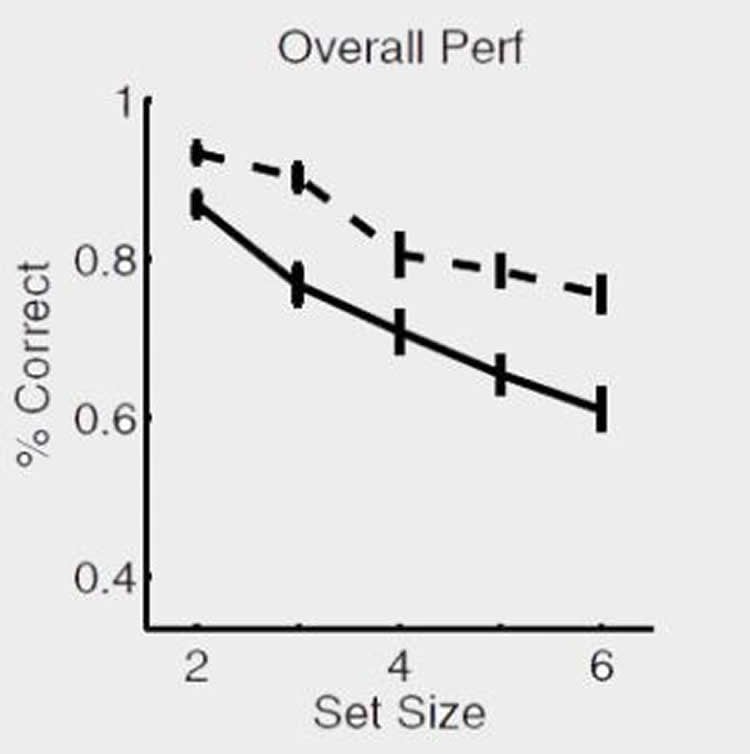Trouble with working memory makes a distinct contribution to the difficulty people with schizophrenia sometimes have in learning, according to a new study. The researchers employed a specially designed experiment and computational models to distinguish the roles of working memory and reinforcement learning.
A new study pinpoints working memory as a source of learning difficulties in people with schizophrenia.
Working memory is known to be affected in the millions of people — about 1 percent of the population — who have schizophrenia, but it has been unclear whether that has a specific role in making learning more difficult, said Anne Collins, a postdoctoral researcher at Brown University and lead author of the study.
“We really tend to think of learning as a unitary, single process, but really it is not,” said Collins, who in 2012 along with co-author Michael Frank, associate professor of cognitive, linguistic, and psychological sciences, developed an experimental task and a computational model of cognition that can distinguish the contributions of working memory and reinforcement in the learning process. “We thought we could try to disentangle that here and see if the impairment was in both aspects, or only one of them.”
In the new study in the Journal of Neuroscience, cognitive scientists Collins and Frank collaborated with schizophrenia experts James Waltz and James Gold of the University of Maryland to measure the effects of working memory and reinforcement in learning by applying these methods. They found that only working memory was a source of impairment.

Learning about learning’s components
To find that out, they marshaled 49 volunteers with schizophrenia and an otherwise comparable set of 36 people without the condition to participate in the specially designed learning task. In each round, participants were shown a set of images and then were asked to push one of three buttons when they saw each image. With each button push they were told whether they had hit the correct button for that image. Over time, through trial and error, participants could learn which picture called for which button. With perfect memory, one wouldn’t need to see an image more than three times to learn the right button to push when it appeared.
The task explicitly involves employing the brain’s systems for working memory (keeping each image–button association in mind) and for reinforcement learning (wanting to repeat an action that led to the feedback of “correct” and to avoid one that produced “incorrect”). But in different rounds while the degree of reinforcement remained the same, the experimenters varied the number of images in the sets the volunteers saw, from two to six. What varied, therefore, was the degree to which working memory was taxed.
What the researchers found was that for both people with schizophrenia and for controls, the larger the image set size, the more trials it took to learn to press the correct button consistently for each image and the longer it took to react to each stimulus. People with schizophrenia generally performed worse on the task than healthy controls.
Those results show that as the task involved more images, it became harder to do – a matter of working memory, since the capacity to maintain information explicitly in memory is limited – but that alone did not prove that working memory was a source of learning problems for people with schizophrenia. They could also be doing worse because of a slower use of the reinforcement.
To determine that, the researchers used their computational models of how learning occurs in the brain to fit the experimental data. They asked what parameters in the models needed to vary to accurately predict the behavior they measured in people with and without schizophrenia.
That analysis revealed that varying parameters of working memory, such as capacity, but not parameters of reinforcement learning, accounted best for differences in behavior between the groups.
“With model-fitting techniques, I can look quantitatively, trial-by-trial and see that the model predicts subject’s choices,” she said. “The same model explains both the healthy group and the patient group, but with differences in parameters.”
That confirmed that working memory uniquely affected learning in people with schizophrenia, while reinforcement learning mechanisms did not, Collins said.
The study suggests that working memory could be a more important target than reinforcement learning among researchers and clinicians hoping to help improve learning for people with schizophrenia, Collins said.
Among mentally healthy people as well, the study illustrates that the different components of learning can be understood individually, even as they all interact in the brain to make learning happen.
“More broadly, it brings attention to the fact that we need to consider learning as a multiactor kind of behavior that can’t be just summarized by a single system,” Collins said. “It’s important to design tasks that can separate them out so we can extract different sources of variance and correctly match them to different neural systems.”
The National Institute of Mental Health supported the research (grant R01MH080066-01).
Contact: David Orenstein – Brown
Source: Brown press release
Image Source: The image is credited to Frank lab/Brown University and is adapted from the press release
Original Research: The research will appear in Journal of Neuroscience. We will provide a link to the research when it becomes available.






